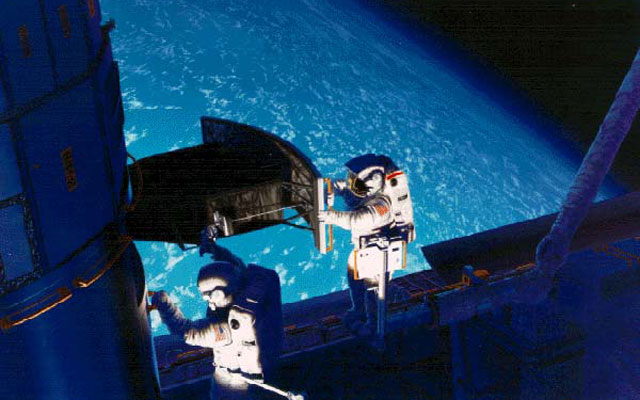
NASA's schoolbus-sized Hubble Space Telescope contains a 2.5-meter-diameter (8-foot) mirror that collects light from extremely distant objects in deep space. This light is brought to focus at a particular point where any one of five onboard instruments can turn it into pictures that are sent by radio to Earth. For almost two decades, the main instrument used for taking general pictures of stars, galaxies and planets had been a JPL Wide Field and Planetary Camera.
Both Wide Field Planetary Camera 1 and 2 actually consist of four internal camera systems: three wide-field cameras, and one narrow-field camera. The wide-field cameras give the telescope a panoramic view, providing the greatest sensitivity for faint objects. The planetary camera provides about 2.2 times the resolution of the other three systems, but with a smaller field of view. All four cameras are sensitive to light from the far ultraviolet to the near infrared.
The original Wide Field/Planetary Camera was installed on the Hubble telescope when it was first launched into Earth orbit on a space shuttle on April 24, 1990. Scientists soon discovered, however, that a tiny error in the curvature of the space telescope's main mirror made it impossible to focus images sharply. Fortunately, JPL engineers determined that by changing the optics of the camera instrument, the telescope's problem could be overcome. The next camera instrument, called the Wide Field and Planetary Camera 2, was installed on the Hubble telescope by spacewalking astronauts on a space shuttle mission launched on December 2, 1993. This brought Hubble's vision to perfect focus.
Over the next decade-and-a-half, JPL's Wide Field and Planetary Camera 2 would take over 135,000 observations of the universe. It images would go on to adorn posters, album covers, screen savers and science text books throughout the world. And in 2007, Hubble's workhorse camera would once again "save Hubble" when the Advanced Camera for Surveys, a more technologically advanced camera than the planetary camera 2, failed. Having been placed aboard Hubble in 2002, the advanced camera had been in orbit five years.
On May 14, 2009, spacewalking astronauts replaced JPL's Wide Field and Planetary Camera 2 with a more advanced system - the Wide Field Camera 3. Hubble's new Wide Field Camera 3 not only looks like JPL's original Wide Field and Planetary Camera 1 and the veteran Wide Field and Planetary Camera 2, it carries its heritage into space with it. The Wide Field Camera 3's housing, radiator and other components came from the original JPL camera, which returned to Earth at the conclusion of the first Hubble servicing mission. On May 24, 2009, JPL's Wide Field and Planetary Camera 2 was returned to Earth in the payload bay of the space shuttle Atlantis. The camera will undergo extensive testing before being put on permanent display in the National Air & Space Museum
The first camera instrument was a joint project of JPL and the California Institute of Technology. The second camera was designed and built by JPL.
Purpose: Main camera instrument on Hubble Space Telescope